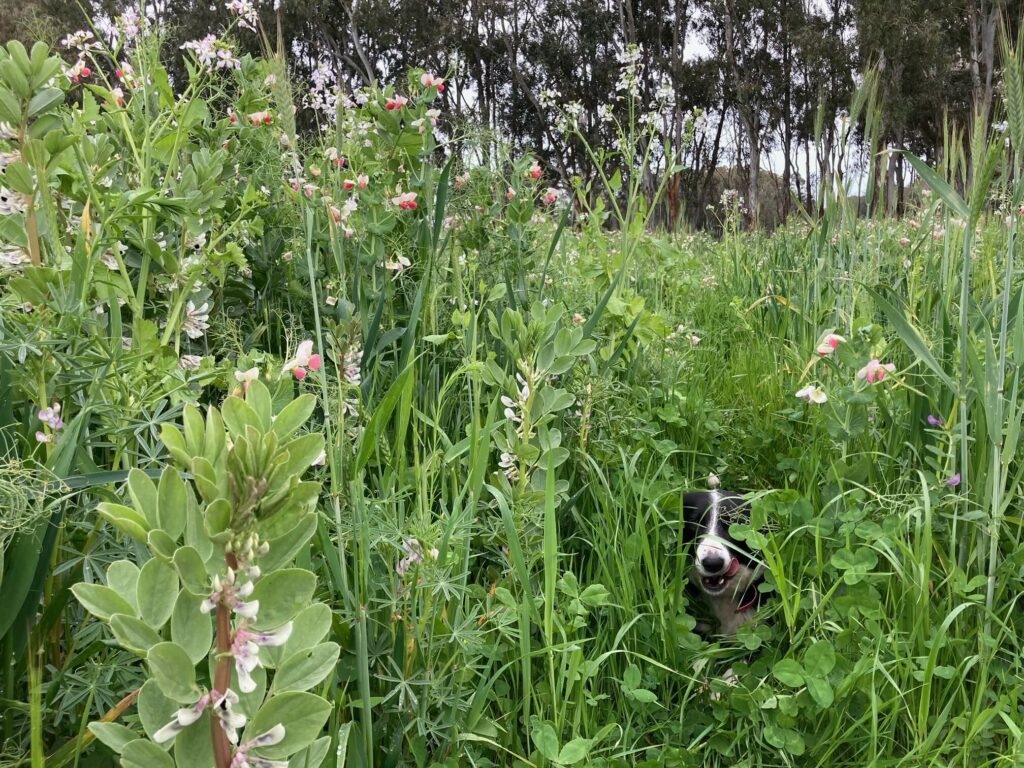Soil is an extraordinary, under-appreciated and misunderstood ecosystem. Soil health not only underpins agricultural productivity but also influences watershed function, water quality and the atmospheric water cycle which is the key driver of earth’s climate. The abundance, vitality and diversity of life in the soil is linked to the abundance, vitality and diversity of almost every other living thing, including birds in the sky and the critters that dwell in rivers, lakes and the margins of the sea. In short, to heal the planet we must heal our soil. To heal soil, we need to understand it.
Sometimes the smallest things can have the biggest impacts. In parallel with research into the human gut microbiome, understanding and supporting the functioning of the soil microbiome is being increasingly recognised as the future for agriculture. Microbes, too small to be seen with the naked eye, are fundamental to almost every process that takes place in soil. Chief among these is the formation of water-stable aggregates. Aggregates provide the ‘crumb’ structure that makes soil porous and friable, like a sponge, enabling water to infiltrate and be stored for later use. Good structure also makes it easy for plant roots to grow. Soil aggregation requires a great deal of work on the part of microbes – and that requires a ton of energy. What form of energy do soil microbes use … and how do they obtain it?
The energy for soil building is derived from photosynthesis, which takes place in the chloroplasts of green leaves. During photosynthesis, light energy from the sun, carbon dioxide from the air and water from the soil are transformed into biochemical energy in the form of sugars. Some of these sugars, laced with a potent brew of carbon-based plant signals, are transferred to the soil microbial community in the form of root exudates. The entire process is termed the Liquid Carbon Pathway (www.amazingcarbon.com)
It’s all part of a virtuous circle. Root exudates provide energy and messages to the microbes that not only form aggregates, but also solubilize and transport plant nutrients. The more extensive the roots and the more rapid the flow of exudates, the more abundant the microbes, the faster the improvement in soil structure, the better the infiltration and the higher the nutrient availability, all of which combine to improve conditions for plant growth. Well-aggregated soil is also less prone to erosion and/or water-logging. Having water move downwards in soil rather than horizontally across the soil surface provides a perennial base flow of clean filtered water to rivers and streams.
BUT… it is important to note that soil building does NOT occur if large quantities of water soluble nitrogen or phosphorus are placed in close proximity to seeds. The ready availability of these essential elements reduces the requirement for plants to provide root exudates to support nitrogen-fixing and/or phosphorus-solubilizing microbes. Reduced root exudation has many unintended consequences. Not the least of these is that the microbes that would normally produce glues and gums to form water-stable aggregates are not supported. Soil loses its structure and becomes compacted. No amount of applied nutrient can counteract soil compaction. An alternative approach is to apply a low rate of a biological stimulant to seeds prior to planting. This has the effect of enhancing the flow of root exudates, improving soil structure in the rhizosphere. Biostimulants include natural products such as vermiliquid, compost extract and fermented seaweed.
Where Do Beneficial Microbes Come From?
One of the reasons biostimulants can be very effective when placed on seeds is that the majority of microbes in the rhizosphere (the soil surrounding plant roots) originate from plant seeds, rather than from the soil itself. Seeds contain hundreds of species of bacteria, archaea, fungi and protists. When a seed germinates the microbes multiply and move into the new roots and the soil surrounding the roots. The plant forms its own microbiome, distinctly different from the microbiome of bulk soil. The presence of microbial stimulants can enhance this process. As the plant grows and develops, microbes that originated in the seed continue to multiply and colonize the newly formed stems, leaves and flowers. Microbes are eventually incorporated back into seeds in readiness for the next generation.
As is the case for water-soluble N and/or P fertilizers, seed-applied fungicides and insecticides disrupt the extremely important communication that normally takes place between germinating seeds and their microbes. The most effective protection against pests and diseases is a flourishing soil ecosystem that supports symbionts such as mycorrhizal fungi and a wide diversity of invertebrates including earthworms and beneficial insects.
Why is Plant Diversity Important?
Microbes function best in teams (consortia) representing a wide variety of functional traits. The rhizosphere microbiome created by plant roots is distinctly different for each plant family. Hence the greater the diversity of plant families in crops, pastures and horticulture, the greater the diversity of microbes and the more robust the entire ecosystem.

Plants from different families share beneficial microbes when their roots mingle. The more diversity we have in our plants, the healthier the ecosystem will be and the faster the soil will be regenerated. Photo by Sam Schinckel
It is difficult to build a house with only plumbers or electricians or carpenters or bricklayers. A faster result can be obtained by assembling a team with a diversity of skills. And so it is with soils. The tradies for soil building come with the plants. The greater the number of families represented in a plant community, the greater the skill base and the better functioning the soil.
Results from the Jena Biodiversity Experiment showed soil beneath plant communities comprising at least four plant families was significantly deeper and better-structured, with higher nutrient status and improved water-holding capacity, compared to the same soil beneath a low diversity of plants. Plant diversity also increased soil carbon sequestration and stabilization and led to increases in beneficial soil fungi.
Why Are Soil Fungi Important?
While bacteria play vitally important roles in soil, they are largely reliant on plant-associated fungi to deliver energy from plant roots. There are many types of soil fungi. Some are seed-associated and form part of the plant’s inherent microbiome, others are opportunistic saprotrophs, while others, such as mycorrhizal fungi, are soil-dwelling obligate symbionts. Irrespective of the type, all forms of beneficial plant-associated fungi transfer energy to the bacterial communities involved in nutrient acquisition and stress tolerance. Soil fungi are also fundamental to the formation of water-stable aggregates.
Mycorrhizal fungi are of special significance. These symbionts provide the infrastructure for the trading of goods and services below ground. Plants connected via common mycorrhizal networks are able to exchange minerals, trace elements, energy and biochemical signals. Mycorrhizal fungi also transport water to plants in dry times. Fungal hyphae extend beyond plant roots and access micropores too small for roots to penetrate. Plant diversity stimulates colonization by mycorrhizal fungi.
Microbial Induction and Legacy Effects
Microbial induction is the natural movement of microbes from one plant to another. This can take place when the roots of plants from different plant families mingle in the same space and time (e.g. multi-species covers and forages and mid-row plantings in tree and vine crops). Microbial induction has also been observed to occur when different species of plants follow each other sequentially. This is termed the ‘legacy effect’. Microbes, especially fungi, left behind by previous plants, can be detected in the roots of the current plants and, if of benefit, may remain indefinitely. Indeed, it is often observed that pastures, crops, vines, trees and even volunteer plants, grow more abundantly following a multi-species cover.
The microbial community a plant encounters at the germination stage can have a large influence on subsequent growth, via mechanisms including nutrient acquisition, resistance to pests and diseases and plant tolerance to stresses such as drought. Creating opportunities for plants to acquire microbes from neighboring plants from different families or legacy microbes from preceding multi-species covers, can improve productivity and resilience. The more frequently multi-species are grown, the better the result. Replacing a warm-season mix with a cool-season mix and then another warm-season mix and so on, with different species in a different place each time, increases the microbial diversity in the entire plant community and all plants become fitter.
In pasture situations it is becoming increasingly common for annuals to be sown with perennials to provide high soil microbial diversity in the initial stages of establishment. The annuals eventually fall away, but the early diversity gives the soil microbiome a boost and gets it off to a good start. It is important to ensure that at least four families of perennials remain once the annuals have finished.
Other factors contributing to progressively improved outcomes in diverse plant communities include the deepening of soils, better aggregation, enhanced infiltration, higher moisture retention and an increased abundance of earthworms. These benefits are cumulative and create positive feedback loops.
Under continuous wheat or corn or soy, or perennial pasture containing only grasses, soil microbial diversity, plant health and soil function often decline over time. In addition, the microbiome of many of today’s plant cultivars has been simplified by decades of excessive fertilizer and pesticide use. Who could have known monocultures were so detrimental to soil health? In our attempts to simplify agricultural production we’ve reduced the complexity that gives soil its vitality.
Restoring richness and vibrancy to the below-ground soil ecosystem through above-ground plant diversity, combined with reduced inputs of toxic chemicals, is fundamental to improving the productivity and resilience of agricultural systems and ultimately, human and planetary health.


(Left) Improved groundcover in vineyard mid-row following multi-species (16 species, 7 families) in previous year compared to (right) voluntary cover in previous year. Photo credit: Ian Adam, Dabblebrook Wines, South Australia
This article first appeared in the 10th Edition of Green Cover's Soil Health Resource Guide.
Also check out the 11th edition, our latest Soil Health Resource Guide, over 90 pages packed with scientific articles and fascinating stories from soil health experts, researchers, farmers, innovators, and more! All as our complimentary gift to you, a fellow soil health enthusiast!
